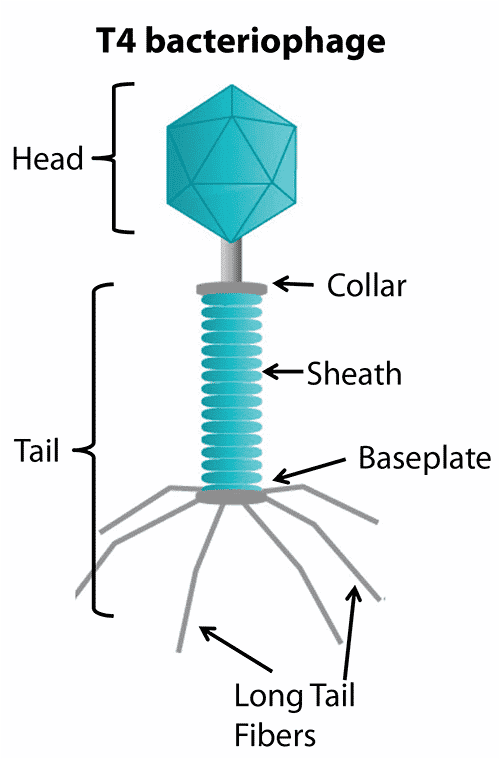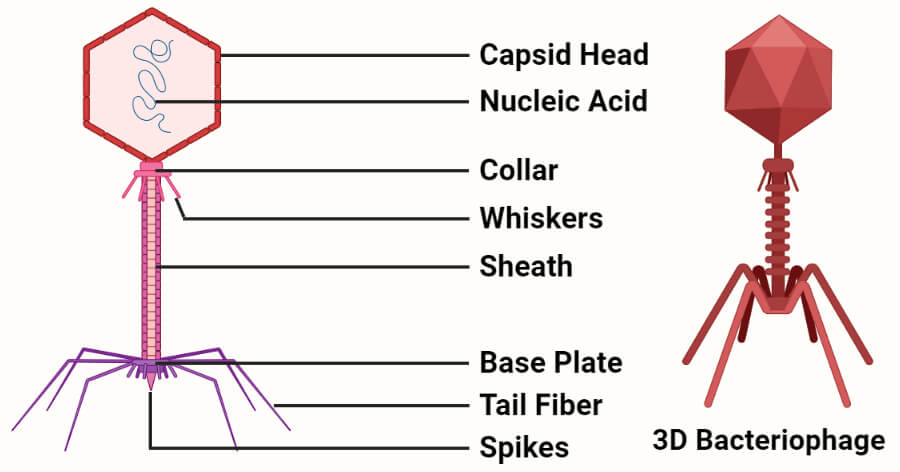Please Explain the Difference Between Virus and Bacteriophage Multiplication
They were discovered independently by two researchers Frederick William Twort 1 at the University of London in 1915 and Félix dHerelle 2 who confirmed the finding and coined the term bacteriophage in 1917 and have been much studied since. The size and shape vary in different species.

Bacteriophage Fact Sheet Morgridge Institute For Research
They are smaller and simpler in structure than even the simplest prokaryotic cells.

. Viruses cause infections by entering and multiplying inside the hosts healthy cells. Bacterial vs viral infection. Textbook solution for Foundations in Microbiology 10th Edition Kathleen Park Talaro Chapter 65 Problem 24CYP.
Coronaviruses cause a variety of diseases in mammals and birds ranging from enteritis in cows and pigs and upper respiratory disease in. Contact 525 South Center St. Figure 614 The one-step multiplication curve for a bacteriophage population follows three steps.
7 rows Comparison of Multiplication Cycles of Bacteriophage and Animal Viruses. Viruses are Viruses are notnot complete living complete living organisms. Like other types of viruses bacteriophages vary a lot in their shape and genetic material.
The capsid is made up of many capsomeres. Bacteriophages can only multiply in the cytoplasm since prokaryotic organisms lack a. Most bacteriophages adsorb to the bacterial cell wall although some are able to adsorb to flagella or pili.
And 3 burst when sufficient numbers of new virions are produced and emerge from the host cell. Specific strains of bacteriophages can only adsorb to specific strain of host bacteria. Plant and animal viruses can enter through endocytosis as you may recall the cell membrane surrounds and engulfs the entire virus.
The T-even phages T2 T4 and T6 were used as model systems for the study of virus multiplication. We have step-by-step solutions for your textbooks written by Bartleby experts. Explain why viruses need cells.
Viruses may enter a host cell either with or without the viral capsid. Viruses do not encode the enzymes required for viral replication on their own. This cycle takes place in the following steps.
In 1952 Alfred Day Hershey and Martha Chase used the T2 bacteriophage in a famous experiment in which they demonstrated that only the nucleic acids of phage molecules were required for their replication within bacteria. Bacteriophage phage are obligate intracellular viruses that specifically infect bacteria. Adsorption during the Lytic Life Cycle of a Lytic Bacteriophage.
Introducing the bacteriophage. A bacteriophage b æ k ˈ t ɪər i oʊ f eɪ dʒ also known informally as a phage ˈ f eɪ dʒ is a virus that infects and replicates within bacteria and archaeaThe term was derived from bacteria and the Greek φαγεῖν phagein meaning to devourBacteriophages are composed of proteins that encapsulate a DNA or RNA genome and may have structures that are either. A virus on the other hand may seize cellular machinery to manufacture new viral particles within a host cell.
You should explain not list at least two similarities and two differences between features of cells and viruses including a brief explanation of the function of those structures. Describe how the structure of a virus compares to the structure of a cell. Start studying Comparison of Bacteriophage and Animal Virus Replication Table 106.
Learn vocabulary terms and more with flashcards games and other study tools. Coronaviruses CoVs enveloped positive-sense RNA viruses are characterized by club-like spikes that project from their surface an unusually large RNA genome and a unique replication strategy. The capsid of a bacteriophage can be icosahedral filamentous or.
The nucleic acid of bacteriophages enters the host cell naked leaving the capsid outside the cell. Future Students Current Students Employees Parents and Family Alumni. 2 eclipse during which entry of the viral genome occurs.
Objective 9 Explain the similarities and differences between viruses 2. A bacteriophage or phage for short is a virus that infects bacteria. 1 inoculation during which the virions attach to host cells.
Viruses can infect bacteria. 1 However because they have some characteristics of life they are important subjects of research for biologists. As the names suggest bacteria cause bacterial infections and viruses cause viral infections.
Lytic Cycle or Virulent Cycle. The burst size is the maximum number of virions produced per. Bacteria are not immune to viral hijackers which are known as bacteriophages viruses that infect bacteria.
The normal process of viral reproduction involving penetration of the cell membrane nucleic acid synthesis and lysis of. The differences and similarities of phage and animal viruses in addition to the definitions of obligate intracellular parasites and phage therapy. Biology is brought to you with support from the Amgen Foundation.
Viruses are smaller and are not cells. A bacteriophage is made up of a protein coat known as a capsid which encapsulates the genome. The results of the experiment supported the.
It consists of a polyhedral head. The ability of a pathogenic virus to lie dormant within a cell. The biology of Zika virus.
Phage genomes can consist of either DNA or RNA and can contain as few as four genes or as many as several hundred. Scientists consider the virome to be the largest the most diverse and the most dynamic part of the microbiome and the majority. We dont want to judge but this may be one more reason to put viruses one notch higher in the nasty germs hierarchy.
In the Lytic Cycle a bacteriophage infects a bacteria and kills it to release progeny virus. The bacteriophage attaches itself on the surface of bacteria. A virus that specifically infects bacteria.
Unlike bacteria they need a host such as a human or animal to multiply. Lysogenic Cycle or Temperate Cycle. What are the similarities and differences of bacteriophages and animal viruses.
It may be enveloped or nonenveloped and have different shapes such as rod-shaped filamentous isometric etc. Bacteriophage exhibits two major types of life cycles. As part of a study of how viruses grow we have been making series of electron micrographs which demonstrate essential steps in the multiplication of the virus-like bacteriophages.
This is known as viral specificity.

The Viral Life Cycle Microbiology

Lytic Vs Lysogenic Understanding Bacteriophage Life Cycles Technology Networks

Viruses Are Both The Villains And Heroes Of Life As We Know It

Bacteriophage Definition Structure Life Cycles Applications Phage Therapy
0 Response to "Please Explain the Difference Between Virus and Bacteriophage Multiplication"
Post a Comment